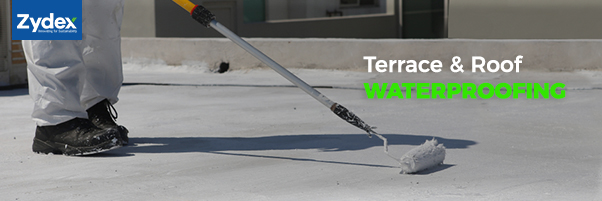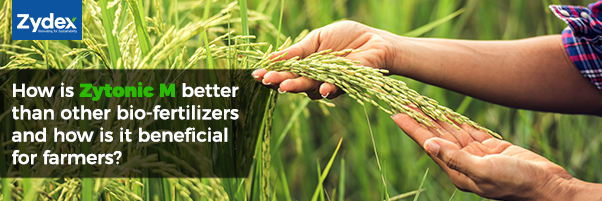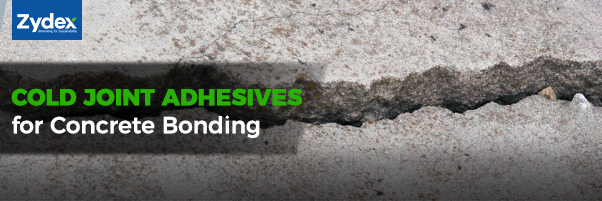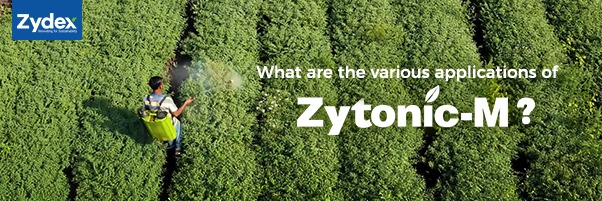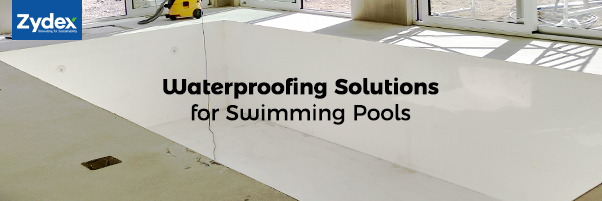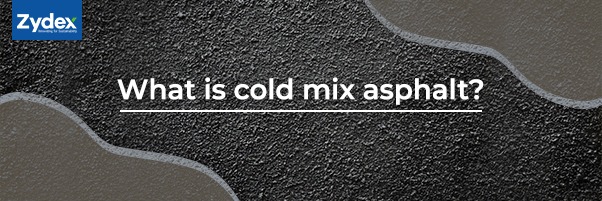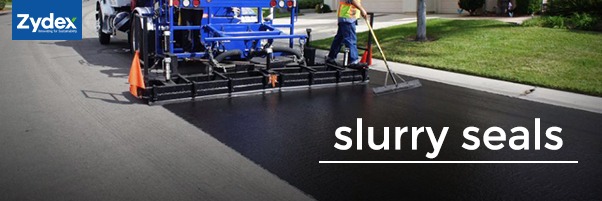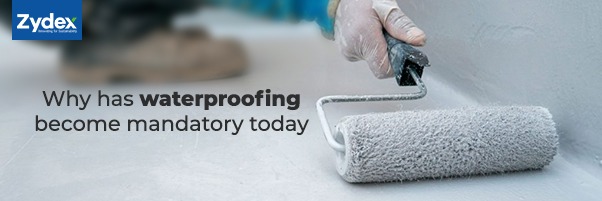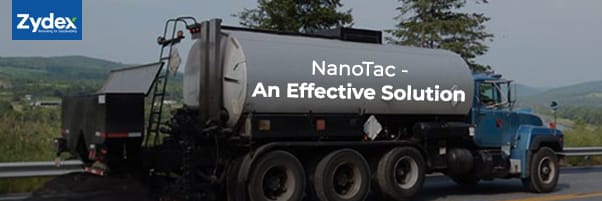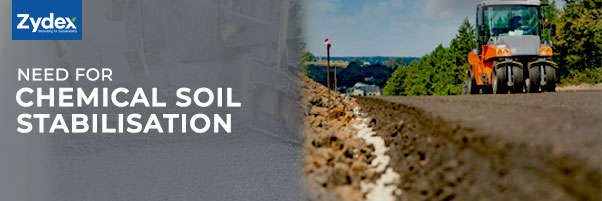Waterproofing of a structure is essential for keeping the structure’s biggest enemy i.e. water from entering. Waterproofing of the terrace/roof is very essential especially in high rainfall areas. We must understand that waterproofing of a project is just 1% of the whole cost but takes care of the 90% of the problems that may damage the building.
The main use of waterproofing of the terrace/roof is to prevent the entering of water into the foundation, roof, walls, basements, buildings and other structures. These are done using waterproofing membranes which are either made of plastic, rubber, coated fabric materials or asphalt sheets.
Application of these waterproofing membranes can be a very time taking and tedious job and requires skilled labour. Any failure in them can lead to failure of the whole treated area. These membranes tend to get rigid & brittle leading to crack within 1-2 years because of the continuous/heavy load.
Zydex provides a solution which is in the form of an elastomeric membrane, Elastobar, which expands up to 250%. This membrane creates a homogeneous layer on the surface which prevents any cracks or pores formation due to joints. The membrane is water resistant, UV stable, highly stretchable and have high bonding strength hence when exposed to weather and continuous load, it does not brittle and break. Application of Elastobar is also very easy, user friendly, less time consuming and no extra source of heat is required. It can be done at any location and do not require skilled labour.
Hence, using Elastobar will continuous protection especially to heavy loaded and exposed areas like terrace/roof.
How is Zytonic M better than other bio-fertilizers and how is it beneficial for farmers?
Agricultural soils today need to produce safe, nutritious and affordable food for all. The world is concerned about deteriorating soil health due to the heavy usage of chemical fertilizers and crop-care chemicals. Moreover, reducing the impact of farming on the environment, human health and well-being of livestock, along with sustainably increasing farmer income, is where the real challenge lies.
Zydex has developed a next generation technology for soil fertility improvement that substantially boosts the natural soil biological population and its functioning efficiency. The Zytonictechnology platformenables bio-farming with reduced chemical inputs and substantial water savings, resulting in higher yields and improved crop quality.
1. Higher Germination:Zytonic M makes soils soft, porous, aerated and improves soil water-holding capacity, thereby improving germination from 70 to75% to 85 to 95%. It ensures 15 to 20% higher plant survival. Higher land occupancy per acre leads to 15 to 20% higher production.
2. Enhanced Plant growth & Quality: Soft and porous soils promote a larger, profuse white root zone with an extended mycorrhiza hyphae network. This along with the enhanced soil biology delivers substantially higher amount of nutrients and also makes them continuously available to the plants throughout the growing season. This results in each plant having a thicker stem, denser canopy and a 15 to 20% increase in flowering & fruiting. A large and biologically active root zone with optimum water, ensures higher nutrient density in the produce. This enhances the aroma, taste and shelf life of the agricultural produce, giving farmers a higher price realization for their farm produce.
3. Water Harvesting & Savings:Zytonic-M ensures that porous soils hold moisture even during drought-like conditions. At the same time, due to the higher infiltration capacity of the soil it allows excess rains to percolate down into the fields easily without flooding. This protects the crop from damage due to anaerobic conditions. Porosity improvement also helps to reduce the salt concentration in the topsoil. Higher infiltration rate means improved rainwater harvesting. Typically, 150-200 thousand liters of water can be recharged every year in ZytonicM fields. The moisture holding capacity improvement in Zytonic M fields also helps to extend the irrigation cycle by 30-40%.
4. Reduced usage of Chemical fertilizers & Pesticide Sprays: Only 20-25% of chemical fertilizers applied are actually utilized by plants. Zytonic-M improves the nutrient uptake capacity of the crops due to a larger and denser root zone with an extended mycorrhiza hyphae network. This ensures a 50% reduction in the need for chemical fertilizers and subsequently lesser irrigation requirement for plant growth. These 2 factors dramatically improve the crops immunity and resistance to pests and fungal attacks leading to a reduction in the number of chemical sprays required.
5. Improved Soil Health & Organic Carbon: The Zytonic-M treated fields have darker green foliage leading to enhanced photosynthetic activity. The higher sugar and carbohydrate production is pushed out as liquid root exudates to feed the enhanced soil biology. This along with remnants from a large root zone builds up soil carbon content, thereby improving soil health.
Cold Joint adhesives for Concrete bonding
Intro
A monolithic structure is very strong in nature and have very few vulnerable points because of no joints. This is not possible in big structures as it cannot be carved out of one structure but has to be made in sections, resulting in a polylithic structure. This leads to multiple joints and resulting in multiple failure or vulnerable points.
Problem
These structure are generally vulnerable to failure/fracture/cracking at the joints between the new and the old surface/structure. These joints are called Cold Joints. Because of these joints, the new and old surface do not act as one and the load or any impact is not evenly shared and making them as the vulnerable points for failure/fracture/cracking.
The same phenomenon is observed during laying of a new PCC/RCC structure and also other surface preparation in sections. During extension of buildings or section-wise structure creation, the PCC/RCC structures are generally left with these cold joints with are the main cause of structural damage and failures.
Solution Zydex provides
Zydex provides a set of solutions which can be applied on the surface easily for achieving the monolithic strength and properties. Cold Bond, is a Zydex solution that can be applied on the old surface (with just a use of brush and do not require any other equipment) and then the new construction can be carried out. These application also do not require skilled labour and can be done very quickly. This solution will create a bond between the two surfaces that allows them to reach monolithic strength making it an easy to use and economical solution for contractors.
What type of crops and soils is Zytonic-M compatible with? What are the various applications of Zytonic-M?
Zytonic-M works on all types of crops and soils. On one hand it improves water-holding capacity in sandy soils, while on the other hand it drains out excess water in high clay soils.
Soil Application
Zytonic-M is a water-soluble powder and hence can be applied either by diluting with water or as a dry powder for both basal and top dressing applications. Zytonic-M is compatible with all types of irrigation systems such as flood, drip, pivot and industrial sprayers.
Additionally, Zytonic-M can be used for Seed Treatment, Nursery Application, Foliar Application and Manure enrichment.
Nursery Application
In nurseries, Zytonic-M can be diluted in water to drench the soil during nursery set-up, or as a dry powder mixed in during seed-bed preparation. 2 kgs of Zytonic-M provides up to 500 square meters of coverage in nurseries.
Foliar Application
Zytonic-M -water solution can be used for foliar application in between top dressing applications to address heat stress or to further boost greenery and vegetative growth.
Enrichment of farm yard manure
Zytonic-M solution can also be used to enrich farm yard manure and improve its bio digestion. The resultant manure is darker and more free flowing with enhanced biological population. This in turn improves the nutrient content of the manure, thereby extending its use over larger acreages.
Waterproofing Solutions for Swimming pools
One of the most challenging points while constructing a swimming pool is that its repair is challenging because it holds a lot amount of water with continuous pressure. Any leak or damage to its surface will cause further damages due to the constant water pressure.
Generally, Contractors use an asphalt sheet or other support sheets for the additional structural stability and extra elasticity to coping with the pressure. These solutions do provide temporary support but get rigid and brittle in 1-2 years. But when any crack or damage to the protective sheets happened due to its brittleness and rigidity, the structure is not able to hold constant pressure. The extra support provided to the surface does not have the elasticity to take care of the load. As a result, this may lead to leakages and structural failure. Thus, Proper construction of the swimming pool is very critical as it does not provide the opportunity of easy repair and is much more of a task if the swimming pool is not at ground level that is on higher floors or rooftop.
For any small or big repair, the swimming pool will be required to be drained and dried before for the treatment. The success of the repair will also be checked after filling the swimming pool and leaving for a minimum of 24 hours. This is a very tedious job and requires a lot of time, effort, and also water gets wasted. That is the main reason the contractors want to provide an ideal waterproofing solution for swimming pools before filling them up.
To help with these problems with the membranes and sheets Zydex provides a solution that is in the form of a waterproofing chemical but on application forms an elastomeric membrane. Elastobar, which can expand up to 250%. This elastomeric waterproofing membrane creates a homogeneous membrane layer on the surface that prevents the formation of any cracks or pores caused due to joints. Zydex waterproofing membrane is water-resistant, UV stable, highly stretchable, and has high bonding strength. Hence when exposed to weather and continuous load, it does not brittle and breaks. Application of Elastobar is also easy and user friendly. To apply Zydex elastomeric solution no extra source of heat is required and can be done at any location. These applications also do not require skilled labour and can be done very quickly.
Hence, using Elastobar will provide continuous protection against the constant load and pressure in the swimming pools and keep the structure hassle-free.
What is cold mix asphalt?
Cold mix asphalt is, just like hot mix asphalt, a combination of aggregates and cutback or bitumen emulsion, commonly used on low traffic roads or rural roads. Cold mix asphalt is produced by emulsifying the asphalt with water and an emulsifier agent, before mixing it with aggregates, to make the asphalt less viscous so that the mix is easier to work with. The mix could be the one comprising of bitumen emulsion, and virgin aggregates or reclaimed asphalt pavements/milled pavements, though the latter would be cost effective. They are used for repairing potholes as well as worn out flexible pavements. Cold mix asphalt also works along flexible pavements and can be produced, either on-site or at mixing plants.
Features &Benefits of Cold Mix Asphalt:
There are a wide range of benefits which makes cold mix asphalt a preferred option. These include the following:
1. Economical:
a. Cold mix asphalt is economical as compared to hot/warm mix asphalt, as this method eliminates the need to heat the aggregates.
b. Using cold mix is cost effective as compared to hot/warm mix asphalt, due to the fact that the mix can be applied directly from the container.
2. Easy to use:
a. No special high tech machinery required as the standard paving equipment can be used for paving.
b. Design of the mix can be altered and determined depending on the type of the aggregate type, climatic condition of the geography of the location it is to be applied,
c. The mix can be used even when the ambient temperature drops, thus reducing the requirement of maintaining the temperature of the asphalt. So it can be used in all weather conditions.
3. Environmental Friendly:
a. As it doesn’t need to be heated like the hot/warm mix asphalt, it eliminates the emissions.
b. This also reduces the carbon footprint left behind after the process.
Benefits of Zydex Technology for Cold Mix
High-performance cold mix asphalt is the need of the industry. Zydex organosilane technology formulated with cationic bitumen emulsion shows improved uniform coverage, reduced clogging of nozzles, improved spray rate and faster setting.
We offer bitumen emulsion additives for Cold mix asphaltto our clients for improved coating efficiency, preventing stripping of the mixes, higher oxidation resistance andbetter fatigue resistance. We specialise in offering eco-friendly technologies that facilitatesustainable road construction, with improved performance.
Slurry Seals
Slurry seal is a homogeneous mixture of bitumen emulsion, water, well-graded aggregates and mineral filler, mixed as per a design formula, and applied to an existing asphalt pavement surface. Slurry seals are laid on the existing pavement, to seal cracks and voids, thereby making the surface weather tight and providing a new look. A slurry seal is similar to that of a fog seal, except that it has aggregates as a part of the mixture.
Slurry seals are used to remedy a broad range of surface distresses on various surfaces such as streets, drive-ways, airfields and parking lots, to extend the pavement life until resurfacing becomes absolutely necessary. Slurry seal applications are prominent on roads with moderate to low distresses and narrow cracks with no rutting. They seal the surface and provide flexibility and offer a rich black colour. They preserve and protect the underlying pavement surface and provide smooth surface with good riding quality.
Slurry seals, typically have three aggregate gradations:
1. Type 1 (fine)
This type has the finest aggregate gradation (smaller than 2.36 mm) and is used for filling small cracks. They are used as a preparatory pavement treatment and are limited to low traffic areas.
2. Type 2 (general)
This type is coarser than the Type 1 slurry, and is the most commonly used slurry seal type. It treats surfaces with moderate raveling, and improves the skid resistance of the existing pavement.
3. Type 3 (coarse)
Type 3 slurry seals consist of the coarsest gradation and is used to treat surfaces with slight depressions, to prevent water ponding and reduce the probability of hydroplaning.
Slurry seals are an economical and cost-effective solution, to build an all-weather, long lasting surface that provides better skid resistance and improved handling characteristics for drivers. Various factors such as traffic, weather, location and existing pavement conditions need to be taken into consideration before deciding on the slurry seal application. Typically, roadways are treated with slurry seals every 5 to 7 years.
Slurry seals are laid using a slurry truck, which holds various compartments to hold aggregates, water, polymer modified emulsion, and additives. These are the mixed in an on-board mixer and the slurry mixture flows out the rear of the truck onto the pavement. Paving crew follows the truck to provide assistance by ensuring that the mixture spreads properly, correcting uncovered areas and keeping the mixture from flowing over the sides. Sometimes, a fabric is dragged behind the slurry truck to ensure a smooth texture on the surface. Once laid, slurry seals require 4 – 6 hours to dry, before the road is opened to traffic.
Slurry seal is a protective asphalt overlay that preserves the underlying pavement surface and provides significant environmental benefits, thus allowing us to take a step towards a greener & sustainable future.
NanoTac is a cationic bitumen emulsion additive that can be used in Slurry systems at 0.1% by weight, to improve the bonding and wetting attributes of the mixes. This ecofriendly and sustainable chemical technology leads to blacker looking slurry mixes with improved moisture resistance.
Why has waterproofing become mandatory today?
Why has waterproofing become mandatory today?
Prolonging the life of the structure and maintaining its durability along with its beauty is a major concern for the property owners. The most important step that needs to be taken is to conduct waterproofing of the concrete, masonry, and other cemented surfaces. It helps in restricting the entry of water in the structure, which is the main cause that results in structural damage and failure. Waterproofing helps in improving the longevity of the structure while also ensuring the prevention of water from high water table areas, flood-prone areas, and high rainfall areas. High rise buildings have made waterproofing mandatory to avoid damage and failures. The material cost of waterproofing is about 1% of the total project cost and takes care of 95% of the leakage and seepage problems that may damage the building.
If waterproofing is not done properly then it can lead to cracks and structural damages in the future.
Most waterproofing chemical solutions available in the market are like a structural film on the surface and do not form a chemical bond with structure. Over a period of time, the surface is exposed to different temperatures, climatic conditions that may lead to peeling or cracking of the film and may cause new crack formation on the surface. Peeling, cracking, and cracks formation will lead to water entrance to the surface.
These membrane based waterproofing chemicals do not provide complete waterproofing rather only provides a temporary solution via physical adhesion.
To solve this problem and provide a long term solution for waterproofing to maintain the health and looks of the structure, Zydex Industries Pvt. Ltd. offers a penetrative nanotechnology solution called Zycossil+ that forms a chemical bond with the surface. This solution penetrates the existing cracks and treats them to make them hydrophobic from hydrophilic. This 100% silane solution reacts with the structure surface and forms a chemical bond that does not get affected by temperature and climate change. This solution also slows down cracking of the surface and makes the whole surface hydrophobic i.e. water repelling in nature. Zycosil+ solution solves problems like leakages, seepages, peel-off, efflorescence, and reduces structural damages. It also provides UV, Heat, and Abrasion stability and safe to apply indoors. The application is very simple and does not require skilled labour. The solution can be sprayed, brushed, or flooded after mixing with water and has a large coverage area. The waterproofing chemical solution provided by Zydex, silane-based chemicals are best for all kind of cementitious surfaces and can be used on both exterior and interior surfaces.
Hence, the Zydex waterproofing solution provides a complete 360-degree solution for protecting the structure and maintains the aesthetic value of a structure for a longer period.
Improving Bond Strength of Tack Coats using Nanotac: A Case Study
Overview
Research has proven that the degree of bonding between pavement layers can significantly affect the overall performance of the pavement structure or overlay. Zydex Industries specifically addresses this unique problem of permanent bonding between asphalt layers with its asphalt additive – NanoTac.
In a study undertaken by the National Center for Asphalt Technology (NCAT) titled: “Effects of NanoTac Additive on Bond Strength and Moisture Resistance of Tack Coats” by Adam Joel Taylor, P.E. (2011), laboratory analysis measured the effects of NanoTac in a tack coat application. The results provide an interesting view into the performance of NanoTac’s organosilane chemistry and its unique bonding characteristics.
Image removed by sender.
NanoTac is an asphalt pavement additive derived from organosilane technology. NanoTac is designed to convert the surface of the treated material (untreated aggregate, soil, or HMA) from a water-loving (hydrophilic) surface to a water-repelling (hydrophobic) surface. The NanoTac additive is added to a diluted tack coat material by blending a small quantity of the additive with the water used to dilute the emulsion. This is designed to improve the water-resistance and bonding strength of the tack coat interface. The NanoTac additive is also designed to lower the surface tension of a cationic emulsion with which it is blended, reducing droplet size and improving spray coverage. NanoTac is also intended to wet, penetrate, and set quickly to reduce the problem of ‘tire pickup,’ a common problem with construction traffic driving over newly placed tack coats, removing the tack, rendering it ineffective.
Effects of Poor Bond Strength
Poor bonding between pavement layers has been known to decrease the structural bearing capacity of a pavement inducing pavement distresses and failures. Problems commonly associated with debonding are premature slippage cracking, top‐down cracking, and fatigue cracking. Past research shows debonding can reduce the pavement’s fatigue life by more than 50% prompting the need for extensive repairs such as full‐depth patches or complete reconstruction.
The best way to prevent debonding from occurring is through good construction practices. A quality tack coat material that provides sufficient bond strength should be used and uniformly applied to the pavement surface. Common issues with tack coat application include non‐uniform spray (often due to clogged nozzles on the spray truck) and tire pickup (tires from construction traffic removing the tack). Quality construction practices are critical to achieving a quality tack coat interface in the field.
The NanoTac Study
The study was performed to evaluate the effect of the NanoTac additive on tack coat bond strength, spreadability, dry time, tire pickup, and moisture susceptibility.
The study also evaluated the properties of a diluted cationic slow setting (CSS) emulsion containing the NanoTac additive versus the properties of a diluted emulsion with no additive.
Testing Procedures
The interlayer bond strength of each core was determined using ALDOT‐430 Standard Test Method for Determining the Bond Strength Between Layers of an Asphalt Pavement. The control emulsion application had a 30% AC residual while the NanoTac modified application had only a 10% AC residual.
Summary
Based on the results of this study, the following conclusions can be made:
The NanoTac modified emulsion (10% AC residual) with a lower residual AC content provided equivalent bond strength to that of a control emulsion (30% AC residual) on an unmilled (new HMA) surface.
All optimum bond strength values for both the control and NanoTac emulsions were greater than 150 psi (1.03MPa). Construction standards recommend a minimum value of 100 psi (0.69MPa) to have adequate bond strength in the field.
For a copy of this study, please contact your regional representative.
Need for chemical soil stabilisation
Chemical Soil Stabilisation is the process of blending and mixing chemical additives to improve the engineering properties of the soil. The efficiency of the stabilisation depends on the reaction between the chemical/stabilizer used and the soil particle composition.
Soil stabilisation using chemical additives is adopted not only to arrest its shrinkage & swelling potential, but also to improve its strength, workability & durability, thus improving their overall performance. The increased performance implies reduced the maintenance costs, significantly improving the overall lifecycle costs of the pavement. It also offers other advantages such as reduced dusting requirements, controlled volume changes to soil and better workability.
The performance of the treated soil depends on the ability of the additives to react with the soil, which places a great emphasis on choosing the stabilizer best suited for a particular type of soil, taking into consideration, not only the improvement of its engineering properties but also considering its economic and environmental impact.
It has been a common practice to use calcium based stabilizers such as cement and lime for stabilisation, due to its notable effect of reduction in plasticity, swelling & shrinkage as well as the increased bearing strength. However, there are certain limitations to using these additives. Stabilisation of soils containing sulphate minerals when treated with lime, causes adverse chemical reactions & formation of an expansive crystalline mineral, causing heaving and other pavement distresses. Exposure of lime treated soils to wetting and drying cycles results in the loss of cohesion between soil and lime particles. Lime & cement applied in the powder form is known to burn unprotected workmen and also causes harmful environmental effects. Moreover, cement manufacturing emits large amounts of CO 2 . Fibers have been considered an effective alternative to help prevent cracks; however, its effectiveness in restricted to certain type of soils.
The use of bitumen emulsion for soil stabilisation is also a notable practice as it imparts water resistance to the soil particles, increases the load bearing capacity & stability of the soil. However, it may not be a cost effective solution as the soil particles require a high dosage of bitumen emulsion in order to provide the same/better level of bonding. Foamed bitumen, i.e. mixture of air, water and bitumen, is also being used for soil stabilisation. It has been proven that by applying foamed bitumen, produces a semi-rigid layer of stabilised soil.
New and emerging technologies such as enzymes and silanes are being preferred over traditional stabilisation methods, to solve the problems of swelling and shrinkage as well as to improve the load bearing capacity and compaction densities of poor soils, with no harmful effects on the environment. Major advantage of using chemical additives for soil stabilisation is that it enables the use of in- situ/locally available soils and aggregates. This decreases the effort and time required for hauling good quality materials from borrow areas, allowing for an efficient use of natural resources. This results in minimized cost of hauling, thereby reducing the cost of construction.


